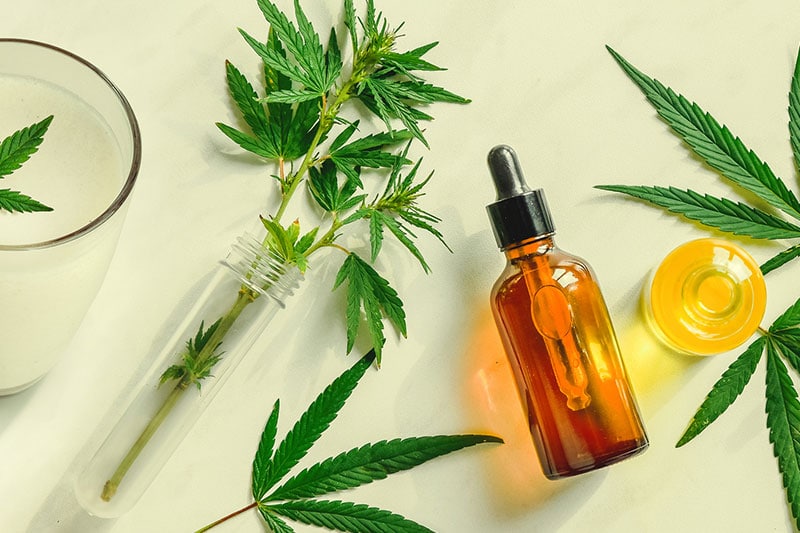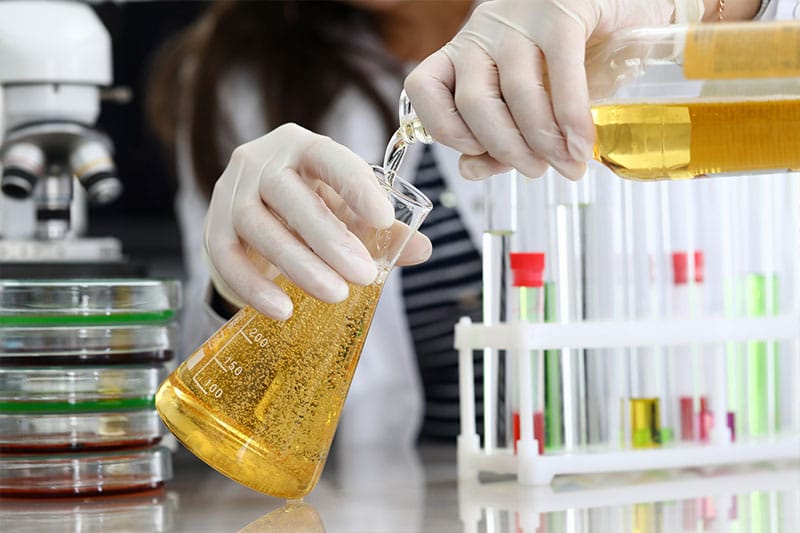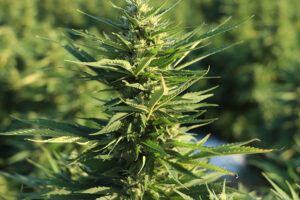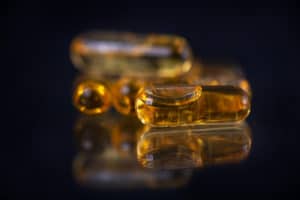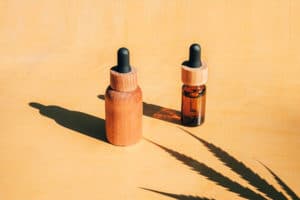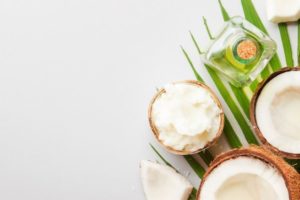Looking to enjoy CBD in one of its purest forms?
CBD distillate might be exactly what you’re looking for. Also known as “the pure,” the extraction method for creating CBD distillate from hemp plants delivers a highly refined form of CBD oil. If you buy the product from a reliable source, you can expect it to have at least 80 percent CBD content.
But CBD distillate doesn’t only contain CBD. It also includes many of the other useful cannabinoids and terpenes that make CBD so effective for improving health and overall wellbeing.
Because of its purity, there are several ways to use CBD distillate. It’s also used to manufacture products like tinctures, vape cartridges, and edibles.
But before you decide whether the product is right for you, let’s shed more light on it by taking a look at what it is, its variations, how it’s made, and more.
What is CBD distillate?
Like we said, CBD distillate is one of the most refined forms of CBD. Because of its high concentration, CBD distillate comes in a thick liquid state that’s as dense as honey. It is so concentrated that you need only a little dose of it to get the desired physiological effects.
Also, because of its highly refined state, CBD distillate has zero impurities, making it one of the safest forms of CBD to consume. It is also tasteless and odorless.
Manufacturers make CBD distillate by first extracting it from either hemp plants or cannabis plants. Most prefer using hemp plants as a source since they already have a higher concentration of the cannabidiol (CBD) compound and less tetrahydrocannabinol (THC).
In most cases, CBD distillate contains anywhere between 80 and 90 percent pure CBD. The other 10 to 20 percent consists of other hemp plant compounds.
Can CBD distillate make me high?
Considering my experience as a cannabis enthusiast, many people exploring CBD products come to me with this question, and I always have the same answer – no, anything remotely CBD will not make you high.
Why? Because the active ingredient in the cannabis plant that is responsible for its intoxicating effects is THC. If you want to experience the high associated with marijuana, opt for a THC distillate instead. Distillates have high potency, with 80-90% concentration of the cannabinoid they possess. Consuming a CBD distillate will instead tap you into its much-needed therapeutic benefits.
CBD distillation – the compounds separated during the process
Since distillation involves separating various compounds from a mixture based on their boiling points, it would be fair to take a look at the compounds that are distilled from the original CBD crude oil to get CBD distillate. These include:
Terpenes
Terpenes are organic, aromatic compounds responsible for the scent of many plants, for example, pinene (pine trees), myrcene (hops plant), limonene (lemons). The cannabis plant has a high concentration of these compounds. Although research is still on-going, terpenes supposedly contribute to the health benefits of CBD.
Plant waxes and lipids
These are complex hydrocarbons that add to a bitter taste of the plant. The extraction of these compounds is essential if you want a pure CBD distillate.
Cannabinoids
Naturally-occurring chemical compounds found in the cannabis plant, namely, THC, CBD, CBG, etc. These compounds react with the endocannabinoid system of the human body and are responsible for the therapeutic and psychoactive properties of the cannabis plant.
Flavonoids
Flavonoids are phytonutrients responsible for the taste and color of a plant. Their extraction can change the taste of the final product.
Types of CBD distillates
There are several variations of CBD products available. What primarily differentiates each type is its level of purity and the hemp compounds it contains, both of which are determined by the manufacturer’s extraction process and the type of distillate.
Knowing what each variety entails is important. Without that knowledge, it’s more difficult to determine which variation of CBD to use to satisfy your health goals. Below are the three main varieties of CBD products:
Full-spectrum CBD
Also known as whole plant CBD, full-spectrum CBD is one of the most popular options on the market. It has a high level of CBD but also contains a significant amount of terpenes and other cannabinoids and hemp compounds. That’s because full-spectrum distillates contain more of the original content of the entire cannabis plant.
People who choose to use this product do so because of the “entourage effect.” The idea behind the entourage effect is that CBD works best when all of the cannabis compounds are present. That is, each compound increases the effects of the others, leading to a higher potency.
Along with other compounds, full-spectrum CBD contains small amounts of THC, which is the ingredient that produces psychoactive effects in cannabis. However, the amount of THC in full-spectrum CBD is much too low to produce these effects. Instead, the small amount of THC is intended to enhance the effects of the CBD.
Research is still ongoing into whether the entourage effect is real, but so far, the evidence points to hemp cannabinoids and terpenes being more effective when they work together.
But on the downside, a lot of consumers are not fans of the earthy taste full-spectrum CBD tends to have. The earthy taste comes from the fact that the extraction process and refinement isn’t as thorough as that of a true CBD distillate or isolate.
Broad-spectrum CBD
Unlike full-spectrum CBD that contains most of the hemp plant’s original compounds, broad-spectrum CBD is a bit more refined. It is a THC-free distillate, meaning it contains most of the other compounds found in the hemp plant, minus the THC.
If you want to eliminate the risks of using a CBD product that contains THC, you are better off using broad-spectrum THC. It also contains fewer impurities due to its higher level of distillation.
On the downside, because of the absence of THC and other compounds in broad-spectrum THC, you get a lower entourage effect with this product.
CBD isolate vs CBD distillate
CBD isolate is the purest form of CBD oil – even purer than CBD distillate. CBD isolate is so pure that some manufacturers make broad-spectrum CBD by first creating CBD isolate then adding other hemp compounds to it. That’s because they know that the distillation process for CBD isolate guarantees that it contains the cannabidiol compound and nothing else.
The process for refining hemp to create CBD isolate is very similar to that of CBD distillate. It only becomes more refined because CBD isolate is processed for much longer than CBD distillate, leading to a CBD content of almost 100 percent. That significantly exceeds CBD distillate’s purity level of 80 to 90 percent.
Due to how much it’s refined, CBD isolate isn’t available in oil form, but rather powder form. It’s usually a white powder that you can use sublingually by placing it under your tongue before swallowing.
And like CBD distillate, isolates are odorless and tasteless. On the downside, there is no entourage effect due to the absence of other hemp compounds in the product.
Since most drug tests test for THC, of which CBD isolate contains zero percent, using CBD isolate is a great choice if you want to completely eliminate the risk of failing a drug test.
CBD distillate vs. CBD Oil – is there a difference?
CBD distillates usually have all the same physical properties as CBD oils. Both have a similar color and crystalize depending on the potency of the product. Crystallization of the product also means that you are getting high-quality CBD distillate or oil.
But, here is the catch: “All CBD distillates are oils, but not all CBD oils are distillates.” Yes, you heard us right.
The thing is, CBD distillate is composed of the therapeutic cannabinoid – CBD only, with all other compounds, consistently removed, making it pure and quite versatile. It can be consumed on its own and used as a foundation for other CBD products.
Many CBD oils available in the market do not go through the same refinery processes specific to CBD distillate and have compounds such as terpenes and flavonoids in them. The presence of these additional compounds decides whether a CBD product is a pure distillate or not.
How to extract CBD concentrate
The process of extracting CBD from a hemp plant and purifying it to create CBD distillate varies from manufacturer to manufacturer.
Many use a solvent-based method that involves the use of liquid solvents like carbon dioxide (CO2) or ethanol for the extraction process. Others use a solvent-less process for cannabis extraction. The solvent-less process utilizes either extreme rinsing or pressure techniques to extract the desired compounds.
Choosing the right equipment for CBD distillation
The purity and consistency of the final product depend on the type of CBD distillation equipment you are using. There are several categories of CBD distillation equipment that you can use, each with its varying degree of temperature, separation rate, final yield, and cost. Let’s take a look at some common ones.
Thin-film distillation
Thin-film distillation requires durable glassware equipment, strong seals, and vacuum-pumps. It forms a thin film of oil over an evaporative surface, increasing the surface area and decreasing the risk of cannabinoid-damage due to heat.
Wiped film distillation
Compared to falling film distillation, this setup has a higher separating ability and is suitable for individuals looking to increase the potency of the final product.
Falling film distillation
Due to its weak separation ability, falling film distillation is perfect for removing more volatile substances such as solvents (ethanol) or terpenes.
Short path distillation
This setup improves performance and reduces the distance CBD vapors travel before evaporation. It is perfect for individuals looking to get a cannabinoid-only distillate. Separation is precise but requires multiple passes.
Solvent-based method: CO2 vs Ethanol extractions
Both CO2 and food-grade ethanol are effective solvents for extracting CBD from hemp plants. Even better, unlike other solvents, CO2 and ethanol leave only minimal traces on the finished product after the extraction process.
Using CO2 requires first transforming it into a liquid state by freezing it. The next step is transforming the liquid CO2 into a “supercritical” state by exposing it to a specific amount of heat and pressure. In this state, the CO2 is both liquid and gas, which is ideal for extracting cannabinoids from hemp plants.
Ethanol, which is a concentrated form of the alcohol found in alcoholic beverages, is effective for extraction because of its high polarity. While the process of using ethanol for extraction is quite similar to using CO2, each option has its unique pros and cons.
For example, ethanol is safe for food processing yet very strong. Its strength makes it suitable for extracting CBD quickly. On the downside, if not used with care, its high polarity can cause it to dissolve water and oil molecules. That can lead to the finished product attracting chlorophyll and having a grassy or earthy taste that consumers may find unappealing.
CO2 extraction may be slower, but it’s safer, cleaner, and more eco-friendly. On the downside, the extraction process may accidentally eliminate some beneficial secondary cannabinoids and medicinal terpenes.
CBD distillate production
While CO2 and ethanol extraction processes are effective, they do leave trace amounts on the extracted product. To get rid of these traces and other impurities, the extracted product still has to undergo distillation, which refines it at a molecular level.
After distillation, what’s left is a finished product with pure cannabinoids and terpenes. The longer the distillation process, the higher the purity. In most cases, the distillation process consists of the following steps.
Winterization
The winterization process is the first step to get rid of the impurities in extracted CBD oil. It is done by pouring the extracted content into a container containing ethanol and chilling it for two days. The purpose of this is to solidify the impurities, causing them to become heavy and settle at the bottom of the container.
After winterization, the ethanol and the solidified impurities are filtered out of the CBD. The next step is using heat to turn the filtered CBD into a vapor that’s fed through a cooling tube. The content that drips out at the end of the cooling tube is a pure distillate.
This process can be repeated several times to further purify the CBD oil.
Decarboxylation
After the entire winterization process, decarboxylation follows. It assists the hemp distillate production by making the inactive hemp cannabinoids active.
Using heat activates the hemp cannabinoids but has the downside of removing many of the heat-sensitive terpenes in the extract. On the upside, it removes earthy tastes from the solution, making the extract flavorless and more palatable for many.
Distillation
The final step is steam distillation or fractional distillation to remove any excess or unwanted compounds from the solution. By the end of this process, the CBD oil can have a purity of over 90 percent.
The look and feel of CBD distillate – How do I tell if my distillate is pure?
Depending on the extraction method, pure CBD distillate is a viscous liquid that crystallizes at room temperature. It should have a golden, yellowish color, much like store-bought honey. Solid CBD distillate even looks like pure honey that has crystallized. As a liquid, CBD distillate should be thick, smooth, and oily.
Due to the intensive refinery process, plant compounds, and other impurities such as waxes, lipids are no longer present in the final product. So your CBD distillate should have no taste or odor. Look for a translucent distillate, something you can look through clearly. CBD distillates that are cloudy are bound to be impure.
Making consumption unique – best ways to use CBD distillate
The purity of CBD distillates makes it a multipurpose CBD product. The high concentrations of CBD can be incorporated into a variety of CBD products available in the market, including:
CBD skin-care products and topicals
Companies are readily infusing CBD distillates into skin-care products and ointments. These topicals are perfect in treating pain and swellings, due to the anti-inflammatory properties of CBD.
Dabbing and Vape Products
Vaping or dabbing CBD distillate is probably the most effortless method of consumption. The vapor is odorless and tasteless (unless you are using flavored varieties), with you experiencing its effects almost immediately.
Edibles
Making CBD infused edibles has never been this easy. CBD distillate goes through a decarboxylation process that activates the cannabinoid. Plus, it has no taste or odor, so your edibles will not be earthy or hemp-like.
CBD tinctures
Tinctures are alcohol-based CBD products which are easy-to-consume and preferred by older cannabis users. All you need to do is mix your CBD distillate with high-proof alcohol at low heat while taking necessary precautions, and you are good to go.
Which CBD product is for you?
Now that you know what CBD distillate is and how it’s different from other variations of CBD, it’s time to decide which the best one for you is.
The right CBD product for you depends on your health goals and which product offers the most pros and least cons to satisfy your needs.
With CBD distillate and isolate, you get the benefit of a product that’s free of impurities. More importantly, because of the high concentration of CBD in both products, you only need a small dose to get the effects you want. Smaller doses mean your supply will last longer, which will save you a lot of money if you need to use CBD regularly.
CBD distillate and isolate are also both flavorless and odorless, which means you’ll have no trouble ingesting them directly or mixing them into your food or drinks.
On the downside, these two types of CBD contain hardly any of the terpenes and other compounds in cannabis that have huge health benefits. That’s especially true with isolate, which is 100 percent CBD and contains no other cannabinoids or terpenes.
If you want to experience the entourage effect and the physiological benefits of cannabis compounds, besides CBD, you may be better off with full-spectrum CBD. But full-spectrum CBD usually has issues with purity because of its earthy smell and taste that most consumers don’t like.
A lot of manufacturers try to mask such odors and tastes by adding flavoring to it. While the flavoring may be enjoyable, there’s no telling what it’s made from and what dangers may be attached to consuming such flavorings, especially if they’re made from artificial materials. As long as you don’t mind the taste and smell of the hemp plant, full-spectrum CBD and its entourage effect benefits can be worthwhile.
The absence of other compounds in CBD distillate and isolates can be an upside if you don’t want a product that contains THC. Since THC can have a psychoactive effect and show up on drug tests, some consumers avoid using it, especially consumers who live or travel to areas where THC is illegal. If you want the full benefits of using CBD oil without impurities or THC, CBD distillate is a great choice.
Discover the purest form of CBD consumption – where to buy the best CBD distillate products?
If you want to explore the goodness of pure CBD distillate products, We can help you bridge the gap between retailers and consumers, while providing you with the information that you need before buying. You can choose from a variety of different brands offering CBD distillate oils and other products. Check out our shop to view high-quality CBD oils that we trust.
Conclusion
CBD distillate and isolate are cleaner and purer products that are ideal for those who want the physiological benefits of CBD and aren’t interested in other cannabis compounds.
Since cannabidiol works better when other cannabis compounds are present (also known as the entourage effect), CBD distillate is a better choice for many users than CBD isolate since it contains 80 percent CBD and 20 percent other compounds.
But don’t take our word for it. The most foolproof way to find which product works best for you is to try them out yourself to see which one benefits you the most.
FAQs About CBD Distillate
Question: What is CBD distillate?
Answer: CBD distillate is one of the most refined forms of CBD. Because of its high concentration, CBD distillate comes in a thick liquid state that’s as dense as honey.
Question: Can CBD distillate make me high?
Answer: The answer is no. Why? Because the active ingredient in the cannabis plant that is responsible for its intoxicating effects is THC.
Question:
What are the compounds that are separated during CBD distillation process?
Answer: The most common compounds that are removed are terpenes, plant waxes, flavonoids, and cannabinoids.
Question: What are the common types of CBD distillates?
Answer: The two common types of CBD distillates are full-spectrum CBD and broad-spectrum CBD.
Question: What is a CBD isolate?
Answer: CBD isolate is the purest form of CBD oil – even purer than CBD distillate. CBD isolate is so pure that some manufacturers make broad-spectrum CBD by first creating CBD isolate then adding other hemp compounds to it.
Question: What is the common form of CBD isolate?
Answer: The most common form of CBD isolate is in powder form.
Question: How to extract CBD concentrate?
Answer: It differs from manufacturer to manufacturer. Many use a solvent-based method that involves the use of liquid solvents like carbon dioxide (CO2) or ethanol for the extraction process. Others use a solventless process for cannabis extraction. The solvent-less process utilizes either extreme rinsing or pressure techniques to extract the desired compounds.
Question: What is the type of equipment used for CBD distillation.
Answer: There are several categories of CBD distillation equipment that you can use. The typical ones are thin-film distillation, wiped film distillation, falling film distillation, and short path distillation.
Question: Are CBD oil distillate and CBD isolate clean?
Answer: CBD distillate and isolate are cleaner and purer products that are ideal for those who want the physiological benefits of CBD and aren’t interested in other cannabis compounds.
Question: How do I tell if my distillate is pure?
Answer: Pure CBD distillate is a viscous liquid that crystallizes at room temperature. It should have a golden, yellowish color, much like store-bought honey. Solid CBD distillate even looks like pure honey that has crystallized. As a liquid, CBD distillate should be thick, smooth, and oily.

